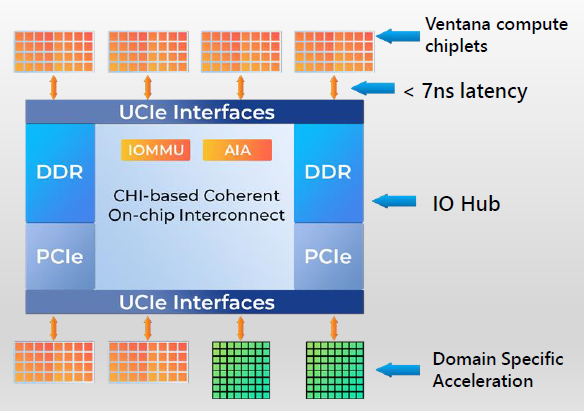Imagination and Ventana to Build a RISC-V CPU-GPU Platform
New RISC-V platform could address client applications.

When you think RISC-V, the first thing that comes to mind are microcontrollers and various special-purpose devices. However, the instruction set architecture is developing and is gaining popularity rapidly. As a result, more applications will adopt RISC-V. Ventana Micro Systems teamed up with Imagination Technologies to build a CPU-GPU platform based on the RISC-V, reports Jon Peddie Research.
Ventana Micro already has a RISC-V-based datacenter-grade Veyron V1 CPU IP (introduced in December 2022) that features an eight-wide execution and an up to 3.60 GHz frequency. The CPU IP is designed to pack 16 cores per cluster and scale up to 192 cores for performance-demanding applications. But as Jon Peddie rightfully reminds us, a CPU is just a CPU as it needs graphics capabilities to display the results of its work. To that end, Ventana had to team up with Imagination Technology for a RISC-V GPU, in order to build a platform that could address a variety of applications.
At the next RISC-V Summit, Ventana plans to unveil an emulation model showcasing how its RISV-C-based CPU works with a GPU developed by Imagination Technologies. This demonstration coincides with the launch of Ventana's Veyron V2, which promises to be a game-changer. The V2 is set to incorporate significant enhancements to the RISC-V instruction set architecture (ISA), bringing it on par with competitors like x86 and Arm.
These enhancements include a hypervisor extension for robust virtualization, an advanced interrupt architecture, and sophisticated debug and trace functions. The Veyron V2 will also feature the RVA23 feature set, which will deliver over a 40% performance increase (presumably over V1), a 512-bit vector unit with AI matrix extensions, a server-grade IOMMU, and domain-specific acceleration. In addition, the platform features RISC-V Software Ecosystem (RISE) software compatibility.
According to Ventana's projections, a 192-core Veyron V2 CPU is significantly ahead of AMD's 96-core EPYC 'Genoa' and 128-core EPYC 'Bergamo' processors in integer computations at the same power. Meanwhile, these are projections and it remains to be seen how the real hardware performs.
The collaboration project between Imagination and Ventana may look virtual for now, but the availability of RISC-V CPU and GPU IP could lead to the development of a RISC-V platform targeting diverse client applications.
Get Tom's Hardware's best news and in-depth reviews, straight to your inbox.

Anton Shilov is a contributing writer at Tom’s Hardware. Over the past couple of decades, he has covered everything from CPUs and GPUs to supercomputers and from modern process technologies and latest fab tools to high-tech industry trends.
-
bit_user Think Silicon (now owned by Synopsis) beat them to it, by almost a year and a half:Reply
https://www.think-silicon.com/?section=2230&language=en_US&itemid1541=3497&detail1541=1
Details from the product page:
NEOX™ is a parallel multicore and multithreaded GPU architecture based on the RISC-V RV64IMFC instruction set with adaptive NoC. The number of cores varies from 4 to 64 organized in 1-16 cluster elements, each configured for cache sizes and thread counts. Depending on cluster/core configuration, NEOX™ compute power ranges from 12.8 to 409.6 GFLOPS at 800MHz with support for FP16, and FP32, and SIMD instructions.
https://www.think-silicon.com/neox
Interestingly, both Imagination (UK) and Think Silicon (Greece) are European-based GPU designers. If you've never heard of the latter, that's because they've exclusively targeted the low-power embedded market.
I think RISC-V perhaps isn't ideal for a scale-up GPU, but it's alright for cases where you don't need the best performance and would rather provide more customizability to end customers and leverage existing codebases & toolchains. -
bit_user ReplyVentana Micro already has a RISC-V-based datacenter-grade Veyron V1 CPU IP (introduced in December 2022) that features an eight-wide execution and an up to 3.60 GHz frequency.
Has this ever been seen in the wild, or at least in actual silicon? Some of the features they said they're adding to the V2 make the V1 sound like it's not particularly usable in a true production environment.
As for this:
I'll believe it when there are independent, 3rd party benchmarks on real hardware. We don't know what kinds of assumptions or modelling went into producing that estimate.
as Jon Peddie rightfully reminds us, a CPU is just a CPU as it needs graphics capabilities to display the results of its work.
Uh, no. Servers (Ventana's primary market) only need a BMC-type solution. You can just drop an ASpeed chip on the board - it doesn't particularly matter what ISA it uses, as there's zero code-sharing between it and the CPU.
It's only for client devices where the matter of integrated graphics becomes important. Even there, it's probably only when you get into the low cost/low power domain that it could start to make sense having flexible retasking of the GPU cores for CPU jobs. -
SunMaster I have high hopes for Risc-v in the more distant future. I standard noone owns always sounds good to me.Reply

